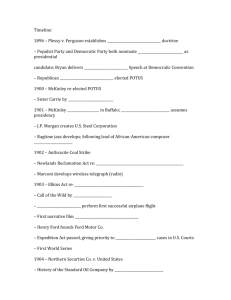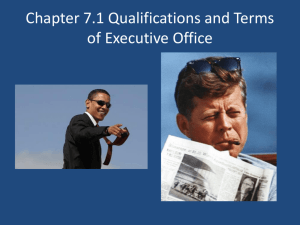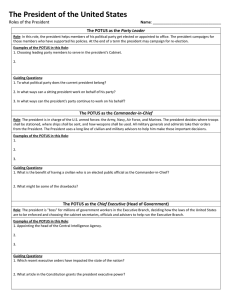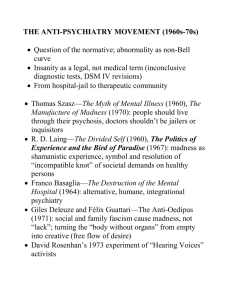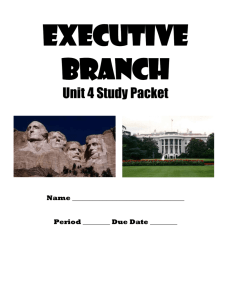Unit 6 APUSH Lecture 6.1
advertisement
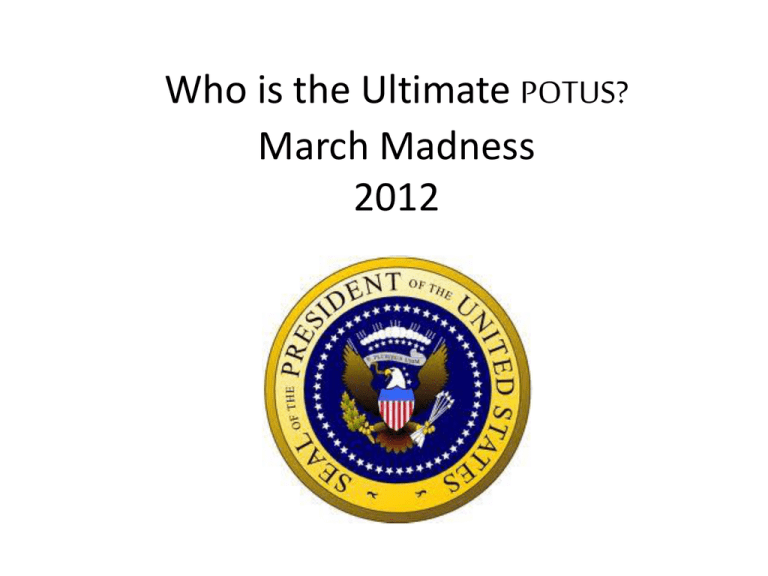
Who is the Ultimate POTUS? March Madness 2012 March Madness 2012 AP US History The Ultimate POTUS! It’s almost March, and that means it’s time for heated rivalries, thrilling upsets, and the menacing run to the Final Four. It’s time to separate the pretenders from the contenders… and we’re not even talking basketball. It’s time for the 1st Annual AP US History March Madness – The Ultimate Presidents Tournament™. Overview – the Tournament in Brief You will assume the role of two presidents or president ial wannabes. You must fight, claw, and scratch your way through the brackets, in search of the title of The Ultimate POTUS. Each round consists of a presidential debate, from which one POTUS will advance and one will go home. In a class showdown, one winner will emerge to seize the crown and claim the title, TOP POTUS. Individual Responsibilities Write a biographical sketch of two Presidents. The biography must include the basic background of the POTUS. More importantly, the biography must emphasize the significance of the person as a leader and their impact on the course of US history. Biographies should be limited in length – less than one typed, single-spaced page. Be concise, yet complete. You may type your biographies. Assume the role of both your POTUS in debate competitions, seeking to advance through the brackets. Sell yourself! Become the president! Defend your legacy! In the debate, you should emphasize your own attributes, but don’t forget to attack the weaknesses of your opponent! . Grading Biographical Sketches (2) = First Round Debate (best of 2) = 50 points (25 points each) 25 points (based on preparation / understanding) 75 points total Extra Credit for each round that you advance in the tournament. Higher seeds receive 3 points for each round, lower seeds receive 2 plus the difference between the two seedings (a 10 seed defeating a 7 seed would receive 2+3=5) Extra credit is built in for the following reasons: 1.To reward those who put in the time to prepare and compete. 2.To give credit to those who must present on multiple occasions. The more you win, the more extra credit, but also the more work and preparation. Selection 1.You will randomly be assigned one potential POTUS from each bracket. The Big Picture 1.Serve on the jury for the Final Four You must serve as an impartial jury member, voting for the winner of the debates that you are not in. Vote for the winner of the debate by balancing the effectiveness of the presentation with the documented merits of the rulers. 2.This is designed to be fun and engaging. Have fun, but don’t get carried away. Let the competition bring out the best in all of us, not the worst. 3.When March Madness if over, all of you will walk away with a packet of 64 of US history’s most significant Leaders. This will be a tremendous study guide for the exam if each individual puts in the time and does a quality job. First… about that last unit • Gilded Age—not guilded • Free Response essays. All essays in APUSH must be self sustaining. You have to restate and reword the question and the parameters of the question or it won’t be read. • A title helps you and your reader focus. ( in other words Free Response #4 is not a title.) Prompt 8 Good Thesis! • • • • Cite at least one figure in each of the following categories and describe the major theme of his or her work. Then tell why you think your choice reflects the reality of life in the late nineteenth century in each case. a. Journalism and popular writing B. Serious novels and poetry C. sculpture and architecture Rosie Trenholm: “During the late nineteenth century, the industrial life dominated for the majority of American people. Factory workers and literature experts alike were effected by the new modern world. Serious novels changed perspectives entirely. Newspaper cartoons highlighted the reality of the corruption in society, and the architecture evolved to fit the demands of the people. The world was not in a pleasant place. All this contributes to the reality of the late nineteenth century’s corruption and industrialism.”
